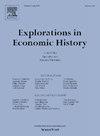日本明治时期的铁路和技术采用
IF 1.7
1区 历史学
Q1 ECONOMICS
引用次数: 0
摘要
铁路通达可以通过多种理论途径加速工业部门的技术进步。通过对19世纪末和20世纪初日本工厂和铁路网络的新数据集进行数字化,并使用优先目的地之间成本最低的路径作为工具,我发现1892年与铁路的距离占1888年至1902年工厂采用的蒸汽动力增长的34%。我还发现了支持形式减少效应背后的几个机制的证据,比如贸易渠道。结果表明,铁路建设在明治日本的快速技术追赶中发挥了重要作用。本文章由计算机程序翻译,如有差异,请以英文原文为准。
Railroads and technology adoption in Meiji Japan
Railroad access may accelerate technological progress in the industrial sector through various theoretical channels. By digitizing novel datasets of factories and railroad networks in late 19th- and early 20th-century Japan and using the least-cost path between prioritized destinations as an instrument, I find that the distance from railroads in 1892 accounts for 34 percent of the growth in steam power adopted by factories from 1888 to 1902. I also find evidence supporting several mechanisms behind the reduced-form effect, such as the trade channel. The results suggest that railroad construction played a significant role in the rapid technological catch-up of Meiji Japan.
求助全文
通过发布文献求助,成功后即可免费获取论文全文。
去求助
来源期刊

Explorations in Economic History
Multiple-
CiteScore
2.50
自引率
8.70%
发文量
27
期刊介绍:
Explorations in Economic History provides broad coverage of the application of economic analysis to historical episodes. The journal has a tradition of innovative applications of theory and quantitative techniques, and it explores all aspects of economic change, all historical periods, all geographical locations, and all political and social systems. The journal includes papers by economists, economic historians, demographers, geographers, and sociologists. Explorations in Economic History is the only journal where you will find "Essays in Exploration." This unique department alerts economic historians to the potential in a new area of research, surveying the recent literature and then identifying the most promising issues to pursue.
 求助内容:
求助内容: 应助结果提醒方式:
应助结果提醒方式:


